Investment Portfolio Construction and Analysis for Mr. Tamar
VerifiedAdded on 2023/05/30
|21
|5226
|109
Project
AI Summary
This project focuses on the application of portfolio management principles to construct an investment portfolio for Mr. Tamar, a 45-year-old farmer seeking retirement planning. The analysis considers Mr. Tamar's investment goals, objectives, and risk tolerance over a 15-20 year investment horizon. The project evaluates various asset classes, investment strategies, and economic factors to determine the optimal asset allocation for Mr. Tamar's portfolio. Key considerations include diversification to mitigate unsystematic risk, correlation between asset classes, and the role of risk-free assets. The project also addresses potential investment risks and outlines the role of TCI Investment Inc. in managing Mr. Tamar's portfolio to achieve his retirement goals.
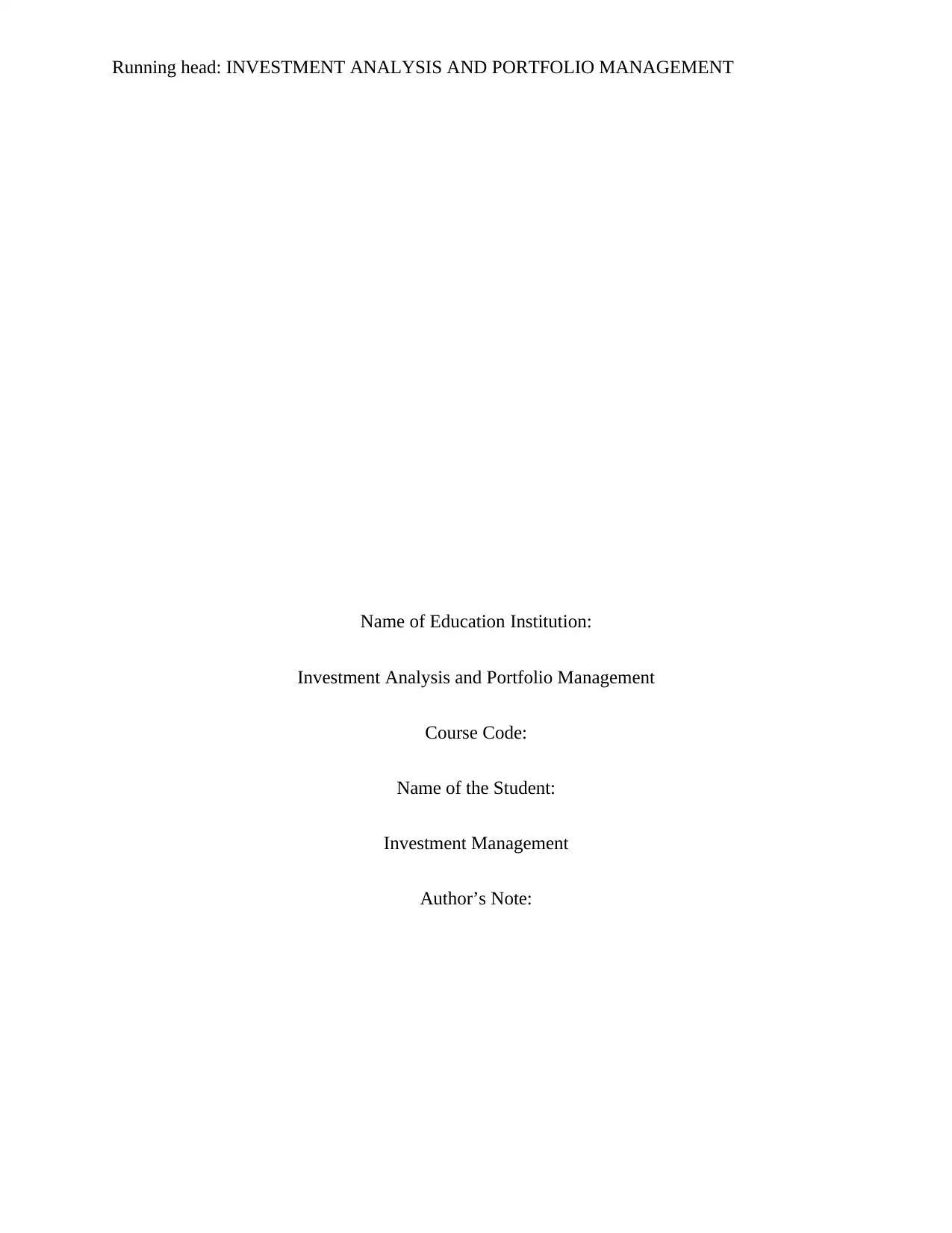
Running head: INVESTMENT ANALYSIS AND PORTFOLIO MANAGEMENT
Name of Education Institution:
Investment Analysis and Portfolio Management
Course Code:
Name of the Student:
Investment Management
Author’s Note:
Name of Education Institution:
Investment Analysis and Portfolio Management
Course Code:
Name of the Student:
Investment Management
Author’s Note:
Paraphrase This Document
Need a fresh take? Get an instant paraphrase of this document with our AI Paraphraser
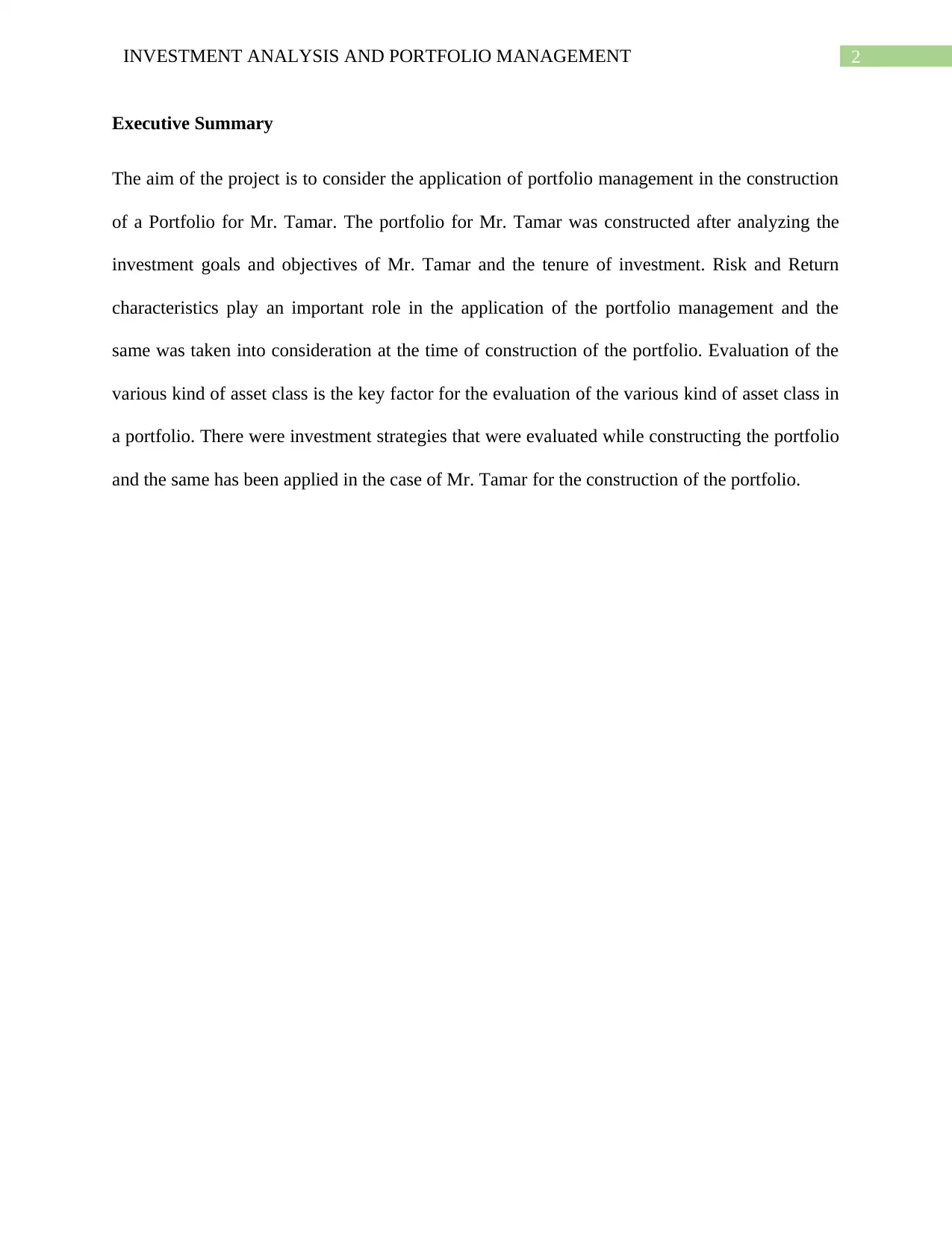
2INVESTMENT ANALYSIS AND PORTFOLIO MANAGEMENT
Executive Summary
The aim of the project is to consider the application of portfolio management in the construction
of a Portfolio for Mr. Tamar. The portfolio for Mr. Tamar was constructed after analyzing the
investment goals and objectives of Mr. Tamar and the tenure of investment. Risk and Return
characteristics play an important role in the application of the portfolio management and the
same was taken into consideration at the time of construction of the portfolio. Evaluation of the
various kind of asset class is the key factor for the evaluation of the various kind of asset class in
a portfolio. There were investment strategies that were evaluated while constructing the portfolio
and the same has been applied in the case of Mr. Tamar for the construction of the portfolio.
Executive Summary
The aim of the project is to consider the application of portfolio management in the construction
of a Portfolio for Mr. Tamar. The portfolio for Mr. Tamar was constructed after analyzing the
investment goals and objectives of Mr. Tamar and the tenure of investment. Risk and Return
characteristics play an important role in the application of the portfolio management and the
same was taken into consideration at the time of construction of the portfolio. Evaluation of the
various kind of asset class is the key factor for the evaluation of the various kind of asset class in
a portfolio. There were investment strategies that were evaluated while constructing the portfolio
and the same has been applied in the case of Mr. Tamar for the construction of the portfolio.
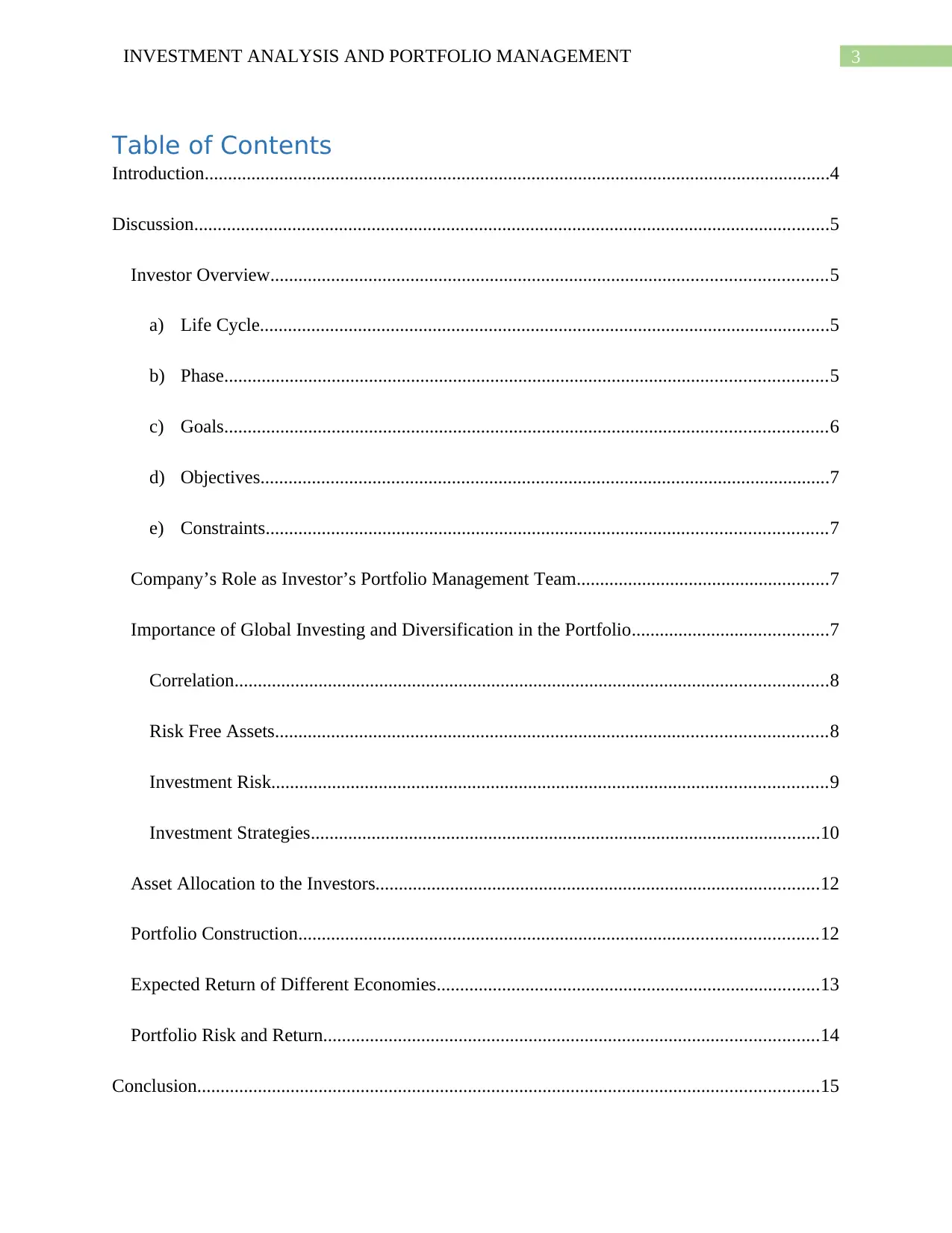
3INVESTMENT ANALYSIS AND PORTFOLIO MANAGEMENT
Table of Contents
Introduction......................................................................................................................................4
Discussion........................................................................................................................................5
Investor Overview.......................................................................................................................5
a) Life Cycle..........................................................................................................................5
b) Phase.................................................................................................................................5
c) Goals.................................................................................................................................6
d) Objectives..........................................................................................................................7
e) Constraints........................................................................................................................7
Company’s Role as Investor’s Portfolio Management Team......................................................7
Importance of Global Investing and Diversification in the Portfolio..........................................7
Correlation...............................................................................................................................8
Risk Free Assets......................................................................................................................8
Investment Risk.......................................................................................................................9
Investment Strategies.............................................................................................................10
Asset Allocation to the Investors...............................................................................................12
Portfolio Construction...............................................................................................................12
Expected Return of Different Economies..................................................................................13
Portfolio Risk and Return..........................................................................................................14
Conclusion.....................................................................................................................................15
Table of Contents
Introduction......................................................................................................................................4
Discussion........................................................................................................................................5
Investor Overview.......................................................................................................................5
a) Life Cycle..........................................................................................................................5
b) Phase.................................................................................................................................5
c) Goals.................................................................................................................................6
d) Objectives..........................................................................................................................7
e) Constraints........................................................................................................................7
Company’s Role as Investor’s Portfolio Management Team......................................................7
Importance of Global Investing and Diversification in the Portfolio..........................................7
Correlation...............................................................................................................................8
Risk Free Assets......................................................................................................................8
Investment Risk.......................................................................................................................9
Investment Strategies.............................................................................................................10
Asset Allocation to the Investors...............................................................................................12
Portfolio Construction...............................................................................................................12
Expected Return of Different Economies..................................................................................13
Portfolio Risk and Return..........................................................................................................14
Conclusion.....................................................................................................................................15
⊘ This is a preview!⊘
Do you want full access?
Subscribe today to unlock all pages.

Trusted by 1+ million students worldwide
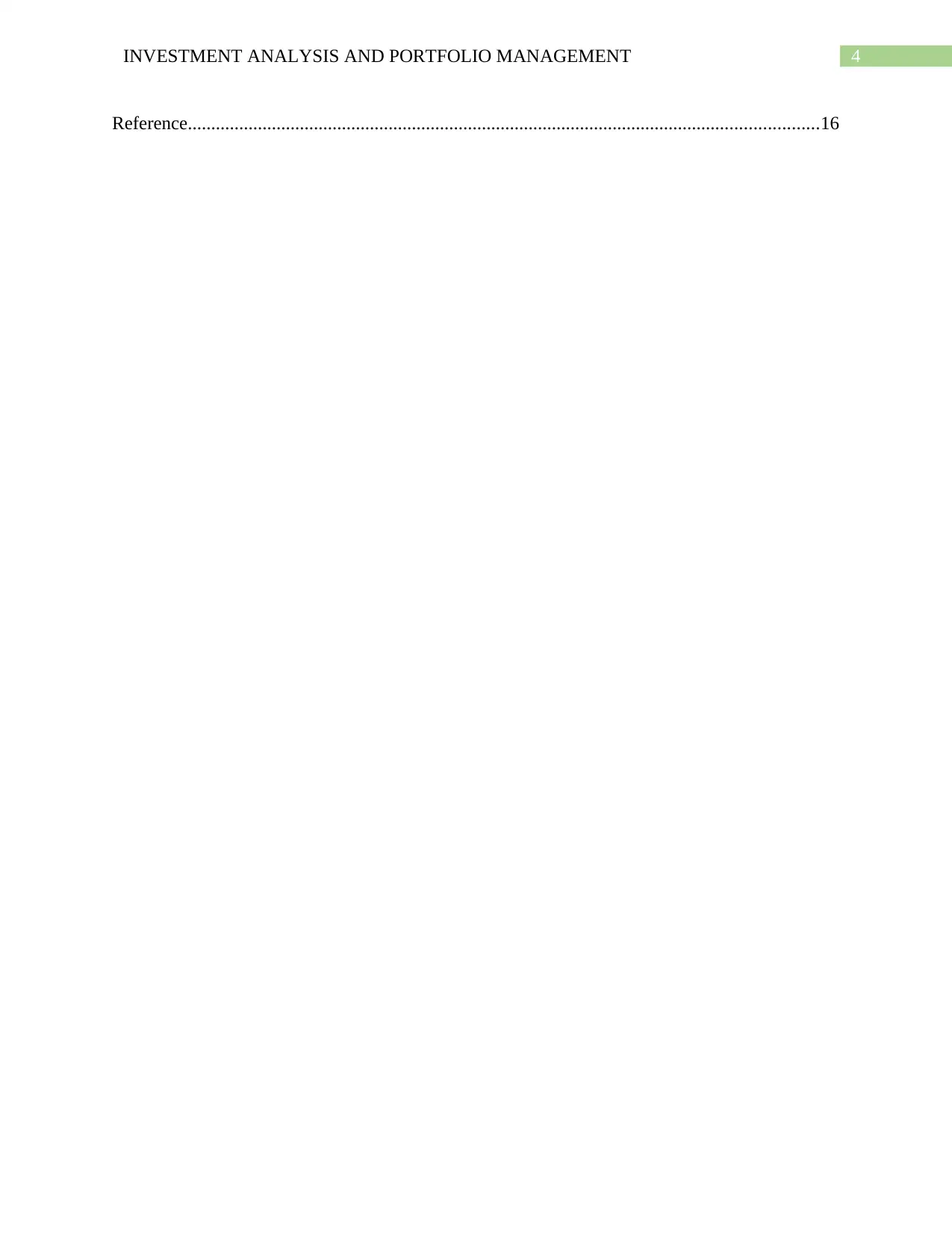
4INVESTMENT ANALYSIS AND PORTFOLIO MANAGEMENT
Reference.......................................................................................................................................16
Reference.......................................................................................................................................16
Paraphrase This Document
Need a fresh take? Get an instant paraphrase of this document with our AI Paraphraser
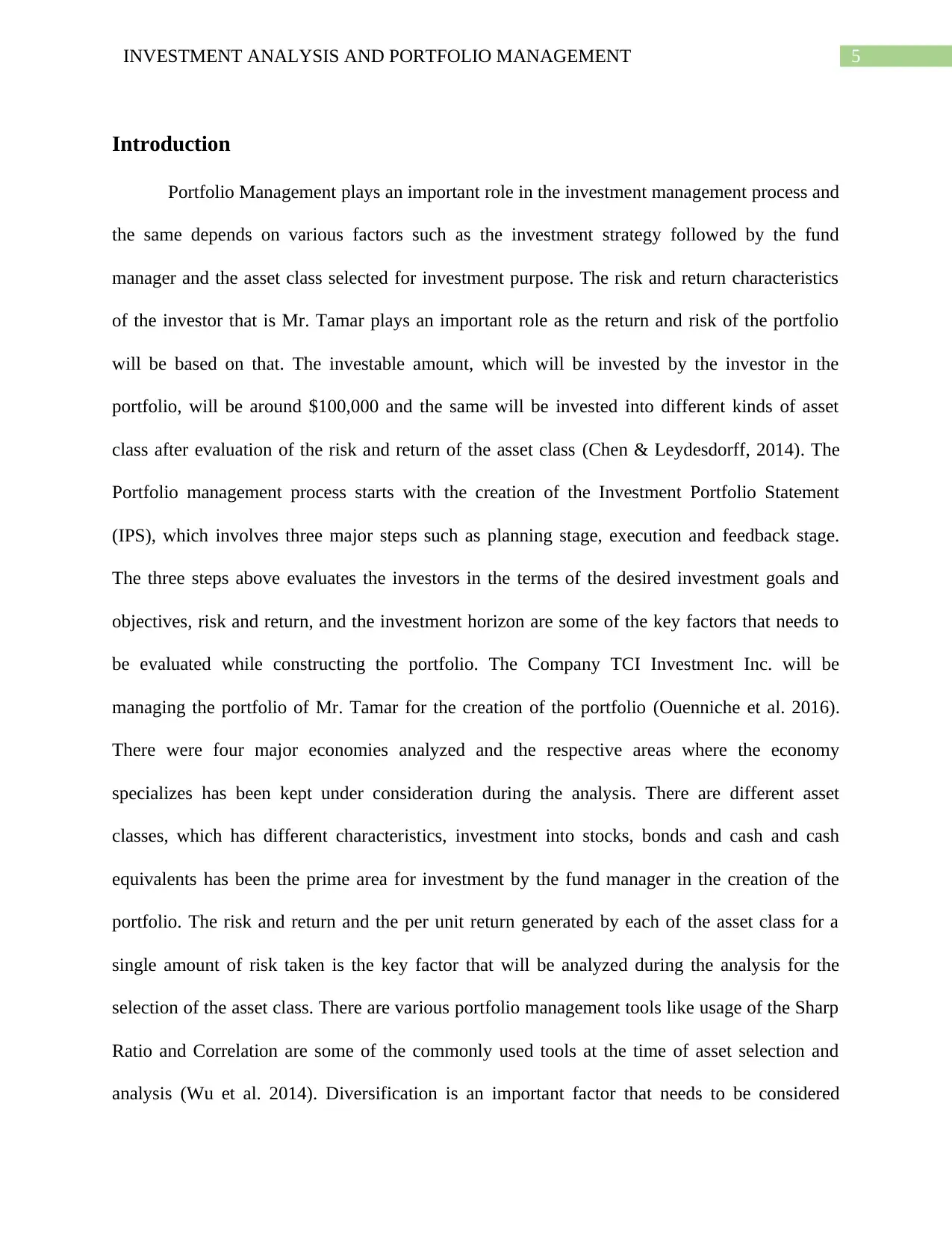
5INVESTMENT ANALYSIS AND PORTFOLIO MANAGEMENT
Introduction
Portfolio Management plays an important role in the investment management process and
the same depends on various factors such as the investment strategy followed by the fund
manager and the asset class selected for investment purpose. The risk and return characteristics
of the investor that is Mr. Tamar plays an important role as the return and risk of the portfolio
will be based on that. The investable amount, which will be invested by the investor in the
portfolio, will be around $100,000 and the same will be invested into different kinds of asset
class after evaluation of the risk and return of the asset class (Chen & Leydesdorff, 2014). The
Portfolio management process starts with the creation of the Investment Portfolio Statement
(IPS), which involves three major steps such as planning stage, execution and feedback stage.
The three steps above evaluates the investors in the terms of the desired investment goals and
objectives, risk and return, and the investment horizon are some of the key factors that needs to
be evaluated while constructing the portfolio. The Company TCI Investment Inc. will be
managing the portfolio of Mr. Tamar for the creation of the portfolio (Ouenniche et al. 2016).
There were four major economies analyzed and the respective areas where the economy
specializes has been kept under consideration during the analysis. There are different asset
classes, which has different characteristics, investment into stocks, bonds and cash and cash
equivalents has been the prime area for investment by the fund manager in the creation of the
portfolio. The risk and return and the per unit return generated by each of the asset class for a
single amount of risk taken is the key factor that will be analyzed during the analysis for the
selection of the asset class. There are various portfolio management tools like usage of the Sharp
Ratio and Correlation are some of the commonly used tools at the time of asset selection and
analysis (Wu et al. 2014). Diversification is an important factor that needs to be considered
Introduction
Portfolio Management plays an important role in the investment management process and
the same depends on various factors such as the investment strategy followed by the fund
manager and the asset class selected for investment purpose. The risk and return characteristics
of the investor that is Mr. Tamar plays an important role as the return and risk of the portfolio
will be based on that. The investable amount, which will be invested by the investor in the
portfolio, will be around $100,000 and the same will be invested into different kinds of asset
class after evaluation of the risk and return of the asset class (Chen & Leydesdorff, 2014). The
Portfolio management process starts with the creation of the Investment Portfolio Statement
(IPS), which involves three major steps such as planning stage, execution and feedback stage.
The three steps above evaluates the investors in the terms of the desired investment goals and
objectives, risk and return, and the investment horizon are some of the key factors that needs to
be evaluated while constructing the portfolio. The Company TCI Investment Inc. will be
managing the portfolio of Mr. Tamar for the creation of the portfolio (Ouenniche et al. 2016).
There were four major economies analyzed and the respective areas where the economy
specializes has been kept under consideration during the analysis. There are different asset
classes, which has different characteristics, investment into stocks, bonds and cash and cash
equivalents has been the prime area for investment by the fund manager in the creation of the
portfolio. The risk and return and the per unit return generated by each of the asset class for a
single amount of risk taken is the key factor that will be analyzed during the analysis for the
selection of the asset class. There are various portfolio management tools like usage of the Sharp
Ratio and Correlation are some of the commonly used tools at the time of asset selection and
analysis (Wu et al. 2014). Diversification is an important factor that needs to be considered
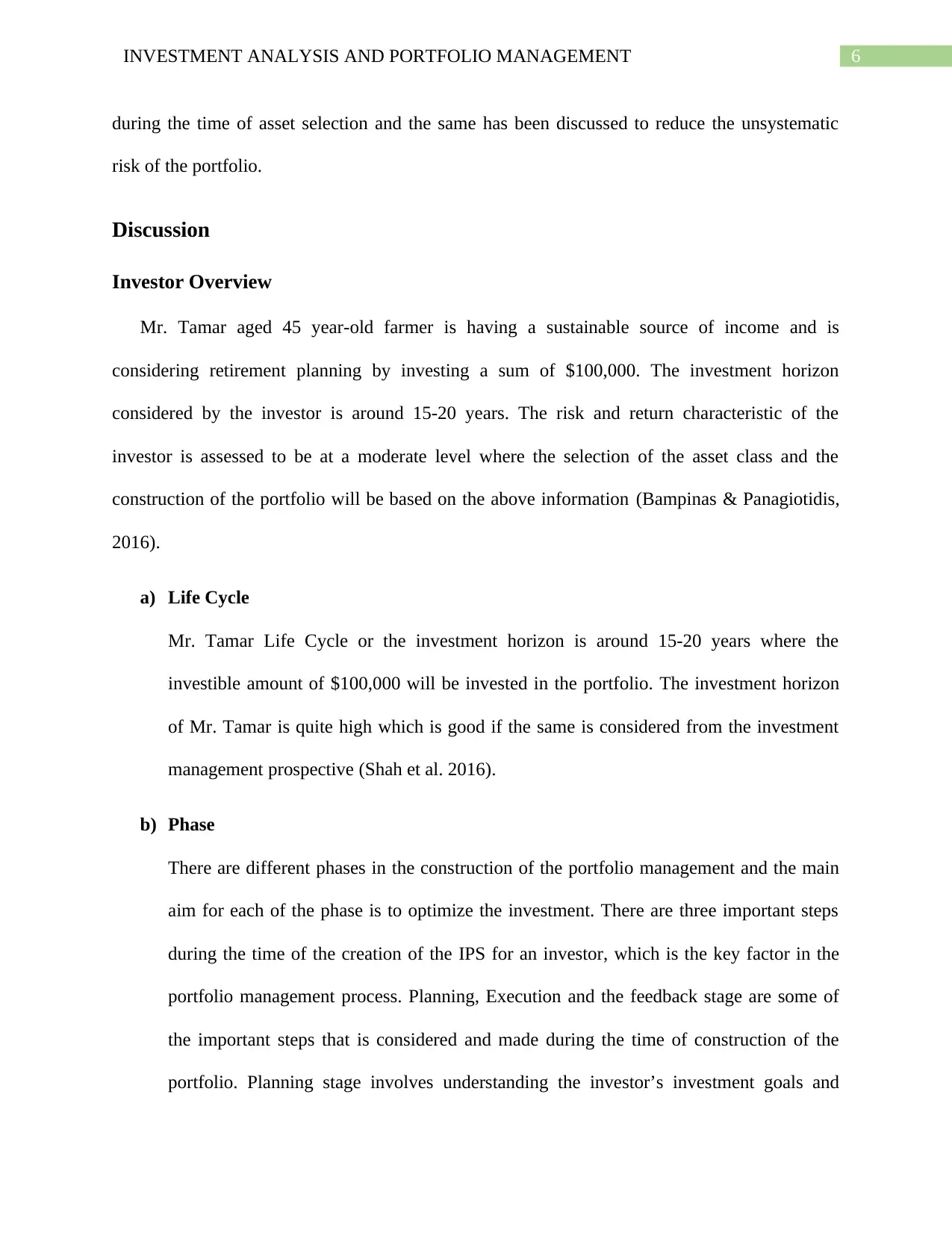
6INVESTMENT ANALYSIS AND PORTFOLIO MANAGEMENT
during the time of asset selection and the same has been discussed to reduce the unsystematic
risk of the portfolio.
Discussion
Investor Overview
Mr. Tamar aged 45 year-old farmer is having a sustainable source of income and is
considering retirement planning by investing a sum of $100,000. The investment horizon
considered by the investor is around 15-20 years. The risk and return characteristic of the
investor is assessed to be at a moderate level where the selection of the asset class and the
construction of the portfolio will be based on the above information (Bampinas & Panagiotidis,
2016).
a) Life Cycle
Mr. Tamar Life Cycle or the investment horizon is around 15-20 years where the
investible amount of $100,000 will be invested in the portfolio. The investment horizon
of Mr. Tamar is quite high which is good if the same is considered from the investment
management prospective (Shah et al. 2016).
b) Phase
There are different phases in the construction of the portfolio management and the main
aim for each of the phase is to optimize the investment. There are three important steps
during the time of the creation of the IPS for an investor, which is the key factor in the
portfolio management process. Planning, Execution and the feedback stage are some of
the important steps that is considered and made during the time of construction of the
portfolio. Planning stage involves understanding the investor’s investment goals and
during the time of asset selection and the same has been discussed to reduce the unsystematic
risk of the portfolio.
Discussion
Investor Overview
Mr. Tamar aged 45 year-old farmer is having a sustainable source of income and is
considering retirement planning by investing a sum of $100,000. The investment horizon
considered by the investor is around 15-20 years. The risk and return characteristic of the
investor is assessed to be at a moderate level where the selection of the asset class and the
construction of the portfolio will be based on the above information (Bampinas & Panagiotidis,
2016).
a) Life Cycle
Mr. Tamar Life Cycle or the investment horizon is around 15-20 years where the
investible amount of $100,000 will be invested in the portfolio. The investment horizon
of Mr. Tamar is quite high which is good if the same is considered from the investment
management prospective (Shah et al. 2016).
b) Phase
There are different phases in the construction of the portfolio management and the main
aim for each of the phase is to optimize the investment. There are three important steps
during the time of the creation of the IPS for an investor, which is the key factor in the
portfolio management process. Planning, Execution and the feedback stage are some of
the important steps that is considered and made during the time of construction of the
portfolio. Planning stage involves understanding the investor’s investment goals and
⊘ This is a preview!⊘
Do you want full access?
Subscribe today to unlock all pages.

Trusted by 1+ million students worldwide
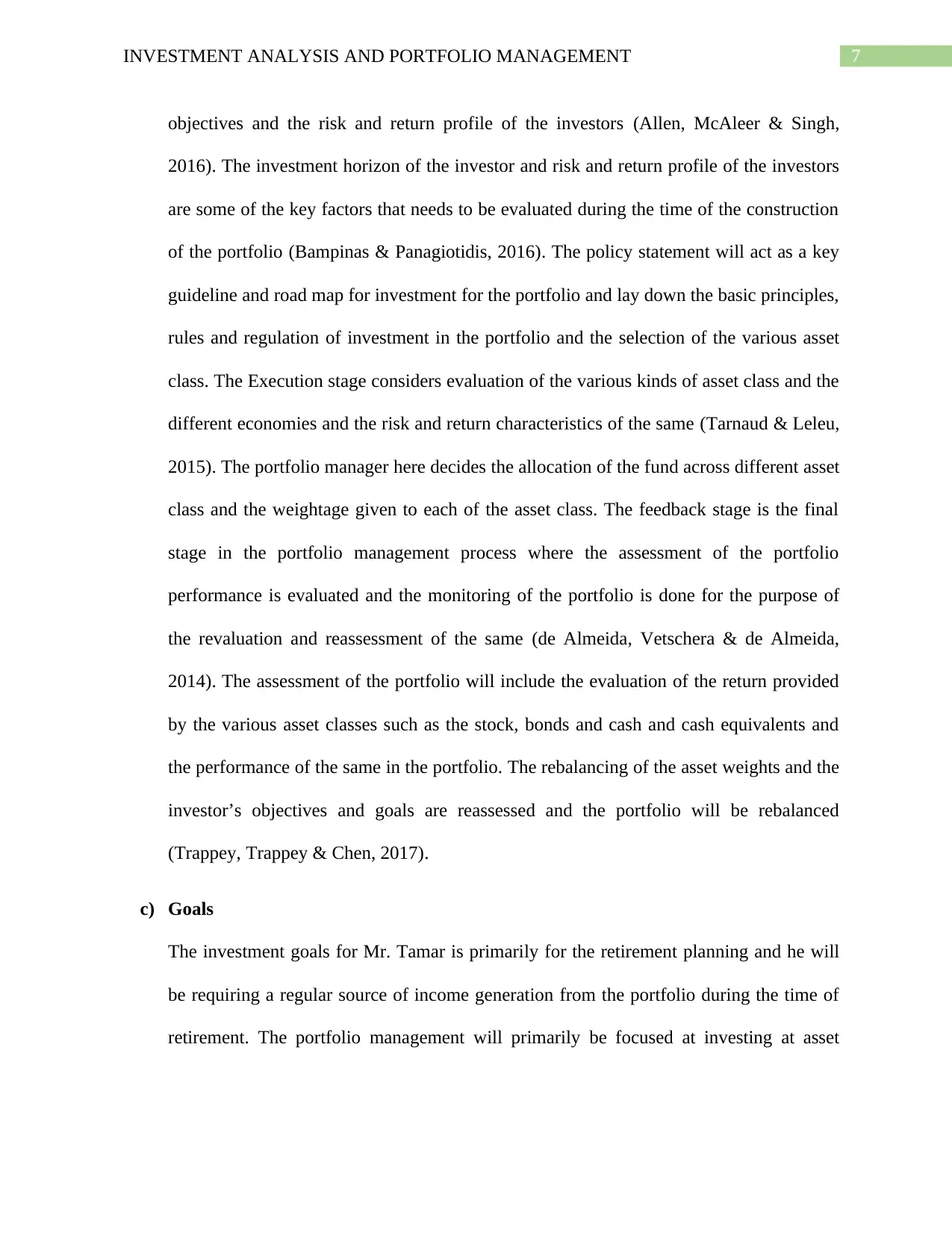
7INVESTMENT ANALYSIS AND PORTFOLIO MANAGEMENT
objectives and the risk and return profile of the investors (Allen, McAleer & Singh,
2016). The investment horizon of the investor and risk and return profile of the investors
are some of the key factors that needs to be evaluated during the time of the construction
of the portfolio (Bampinas & Panagiotidis, 2016). The policy statement will act as a key
guideline and road map for investment for the portfolio and lay down the basic principles,
rules and regulation of investment in the portfolio and the selection of the various asset
class. The Execution stage considers evaluation of the various kinds of asset class and the
different economies and the risk and return characteristics of the same (Tarnaud & Leleu,
2015). The portfolio manager here decides the allocation of the fund across different asset
class and the weightage given to each of the asset class. The feedback stage is the final
stage in the portfolio management process where the assessment of the portfolio
performance is evaluated and the monitoring of the portfolio is done for the purpose of
the revaluation and reassessment of the same (de Almeida, Vetschera & de Almeida,
2014). The assessment of the portfolio will include the evaluation of the return provided
by the various asset classes such as the stock, bonds and cash and cash equivalents and
the performance of the same in the portfolio. The rebalancing of the asset weights and the
investor’s objectives and goals are reassessed and the portfolio will be rebalanced
(Trappey, Trappey & Chen, 2017).
c) Goals
The investment goals for Mr. Tamar is primarily for the retirement planning and he will
be requiring a regular source of income generation from the portfolio during the time of
retirement. The portfolio management will primarily be focused at investing at asset
objectives and the risk and return profile of the investors (Allen, McAleer & Singh,
2016). The investment horizon of the investor and risk and return profile of the investors
are some of the key factors that needs to be evaluated during the time of the construction
of the portfolio (Bampinas & Panagiotidis, 2016). The policy statement will act as a key
guideline and road map for investment for the portfolio and lay down the basic principles,
rules and regulation of investment in the portfolio and the selection of the various asset
class. The Execution stage considers evaluation of the various kinds of asset class and the
different economies and the risk and return characteristics of the same (Tarnaud & Leleu,
2015). The portfolio manager here decides the allocation of the fund across different asset
class and the weightage given to each of the asset class. The feedback stage is the final
stage in the portfolio management process where the assessment of the portfolio
performance is evaluated and the monitoring of the portfolio is done for the purpose of
the revaluation and reassessment of the same (de Almeida, Vetschera & de Almeida,
2014). The assessment of the portfolio will include the evaluation of the return provided
by the various asset classes such as the stock, bonds and cash and cash equivalents and
the performance of the same in the portfolio. The rebalancing of the asset weights and the
investor’s objectives and goals are reassessed and the portfolio will be rebalanced
(Trappey, Trappey & Chen, 2017).
c) Goals
The investment goals for Mr. Tamar is primarily for the retirement planning and he will
be requiring a regular source of income generation from the portfolio during the time of
retirement. The portfolio management will primarily be focused at investing at asset
Paraphrase This Document
Need a fresh take? Get an instant paraphrase of this document with our AI Paraphraser
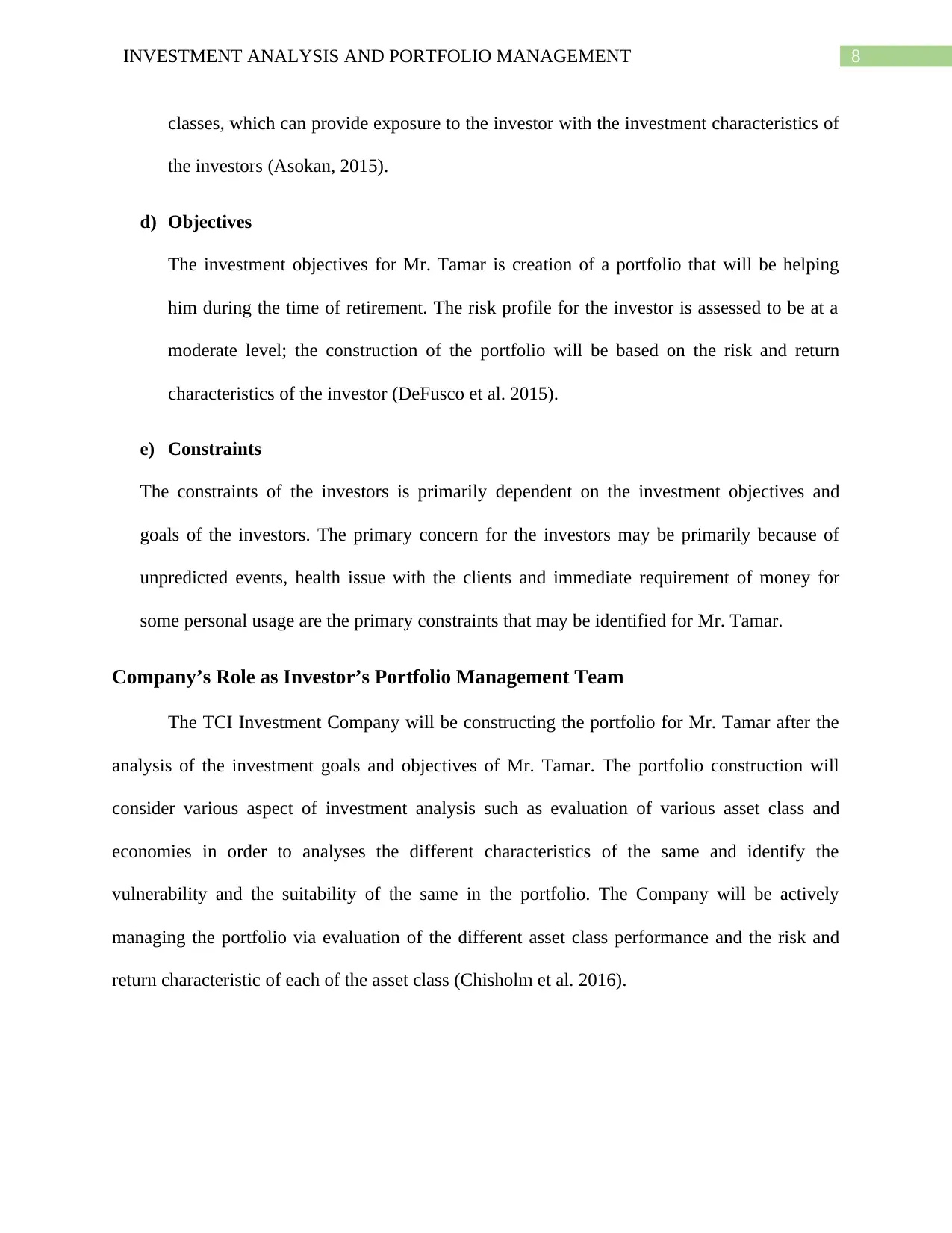
8INVESTMENT ANALYSIS AND PORTFOLIO MANAGEMENT
classes, which can provide exposure to the investor with the investment characteristics of
the investors (Asokan, 2015).
d) Objectives
The investment objectives for Mr. Tamar is creation of a portfolio that will be helping
him during the time of retirement. The risk profile for the investor is assessed to be at a
moderate level; the construction of the portfolio will be based on the risk and return
characteristics of the investor (DeFusco et al. 2015).
e) Constraints
The constraints of the investors is primarily dependent on the investment objectives and
goals of the investors. The primary concern for the investors may be primarily because of
unpredicted events, health issue with the clients and immediate requirement of money for
some personal usage are the primary constraints that may be identified for Mr. Tamar.
Company’s Role as Investor’s Portfolio Management Team
The TCI Investment Company will be constructing the portfolio for Mr. Tamar after the
analysis of the investment goals and objectives of Mr. Tamar. The portfolio construction will
consider various aspect of investment analysis such as evaluation of various asset class and
economies in order to analyses the different characteristics of the same and identify the
vulnerability and the suitability of the same in the portfolio. The Company will be actively
managing the portfolio via evaluation of the different asset class performance and the risk and
return characteristic of each of the asset class (Chisholm et al. 2016).
classes, which can provide exposure to the investor with the investment characteristics of
the investors (Asokan, 2015).
d) Objectives
The investment objectives for Mr. Tamar is creation of a portfolio that will be helping
him during the time of retirement. The risk profile for the investor is assessed to be at a
moderate level; the construction of the portfolio will be based on the risk and return
characteristics of the investor (DeFusco et al. 2015).
e) Constraints
The constraints of the investors is primarily dependent on the investment objectives and
goals of the investors. The primary concern for the investors may be primarily because of
unpredicted events, health issue with the clients and immediate requirement of money for
some personal usage are the primary constraints that may be identified for Mr. Tamar.
Company’s Role as Investor’s Portfolio Management Team
The TCI Investment Company will be constructing the portfolio for Mr. Tamar after the
analysis of the investment goals and objectives of Mr. Tamar. The portfolio construction will
consider various aspect of investment analysis such as evaluation of various asset class and
economies in order to analyses the different characteristics of the same and identify the
vulnerability and the suitability of the same in the portfolio. The Company will be actively
managing the portfolio via evaluation of the different asset class performance and the risk and
return characteristic of each of the asset class (Chisholm et al. 2016).
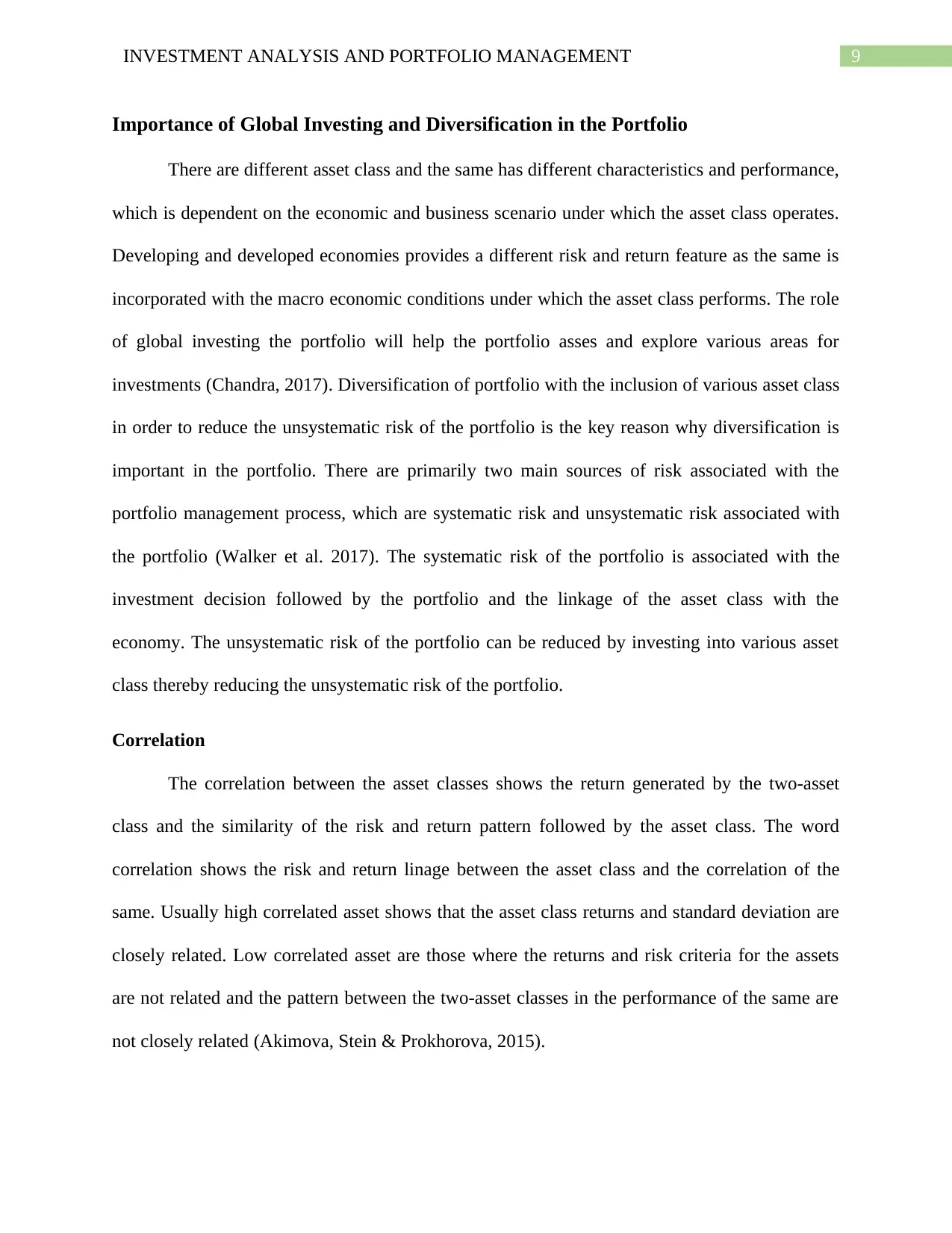
9INVESTMENT ANALYSIS AND PORTFOLIO MANAGEMENT
Importance of Global Investing and Diversification in the Portfolio
There are different asset class and the same has different characteristics and performance,
which is dependent on the economic and business scenario under which the asset class operates.
Developing and developed economies provides a different risk and return feature as the same is
incorporated with the macro economic conditions under which the asset class performs. The role
of global investing the portfolio will help the portfolio asses and explore various areas for
investments (Chandra, 2017). Diversification of portfolio with the inclusion of various asset class
in order to reduce the unsystematic risk of the portfolio is the key reason why diversification is
important in the portfolio. There are primarily two main sources of risk associated with the
portfolio management process, which are systematic risk and unsystematic risk associated with
the portfolio (Walker et al. 2017). The systematic risk of the portfolio is associated with the
investment decision followed by the portfolio and the linkage of the asset class with the
economy. The unsystematic risk of the portfolio can be reduced by investing into various asset
class thereby reducing the unsystematic risk of the portfolio.
Correlation
The correlation between the asset classes shows the return generated by the two-asset
class and the similarity of the risk and return pattern followed by the asset class. The word
correlation shows the risk and return linage between the asset class and the correlation of the
same. Usually high correlated asset shows that the asset class returns and standard deviation are
closely related. Low correlated asset are those where the returns and risk criteria for the assets
are not related and the pattern between the two-asset classes in the performance of the same are
not closely related (Akimova, Stein & Prokhorova, 2015).
Importance of Global Investing and Diversification in the Portfolio
There are different asset class and the same has different characteristics and performance,
which is dependent on the economic and business scenario under which the asset class operates.
Developing and developed economies provides a different risk and return feature as the same is
incorporated with the macro economic conditions under which the asset class performs. The role
of global investing the portfolio will help the portfolio asses and explore various areas for
investments (Chandra, 2017). Diversification of portfolio with the inclusion of various asset class
in order to reduce the unsystematic risk of the portfolio is the key reason why diversification is
important in the portfolio. There are primarily two main sources of risk associated with the
portfolio management process, which are systematic risk and unsystematic risk associated with
the portfolio (Walker et al. 2017). The systematic risk of the portfolio is associated with the
investment decision followed by the portfolio and the linkage of the asset class with the
economy. The unsystematic risk of the portfolio can be reduced by investing into various asset
class thereby reducing the unsystematic risk of the portfolio.
Correlation
The correlation between the asset classes shows the return generated by the two-asset
class and the similarity of the risk and return pattern followed by the asset class. The word
correlation shows the risk and return linage between the asset class and the correlation of the
same. Usually high correlated asset shows that the asset class returns and standard deviation are
closely related. Low correlated asset are those where the returns and risk criteria for the assets
are not related and the pattern between the two-asset classes in the performance of the same are
not closely related (Akimova, Stein & Prokhorova, 2015).
⊘ This is a preview!⊘
Do you want full access?
Subscribe today to unlock all pages.

Trusted by 1+ million students worldwide

10INVESTMENT ANALYSIS AND PORTFOLIO MANAGEMENT
Risk Free Assets
The risk free assets are those assets where the risk of the assets are almost negligible due
to the characteristic of the asset class. The government introduces various kinds of Treasury
Bonds, Bills and paper whose returns are considered for the evaluation of the benchmark purpose
for various different kind of asset class. The risk free assets are generally risk free and Mr.
Tamar can put a small amount of its total portfolio investible amount of money so that the
emergency requirement of Mr. Tamar can be meet up easily (Cohen et al. 2018).
Investment Risk
Investment Analysis follows a wide perspective of investment where the risk associated
with the investment is dependent on the various factors and issue that may need to be evaluated
so that the same can be mitigated (van Loon & Aalbers 2017). Evaluation and Identification of
the various kinds of risk associated with the investment and the effect of the same on the
portfolio needs to be carefully recognized so that the impact of the same can be mitigated. Mr.
Tamar portfolio may be concentrated with various kinds of risk and the same are as follows:
Asset Allocation/Selection Risk: The Risk classifies about the investible asset class and the
performance of the same with respect to the performance of the same in the portfolio. Investment
risk is closely related to the allocation risk, which specify whether the asset class selected for
investment are suitable, or not for the investor according to the risk and return characteristics of
the investors (Dawid et al. 2017). Asset selected for the inclusion in portfolio should be carefully
analyzed and the performance of the assets over the past trend year needs to be carefully
analyzed so that the future returns generated by the asset class are sustainable.
Market Risk: Asset class in the portfolio are always susceptible to the changing market
conditions and the performance of the asset class during the allocation of the asset class in the
Risk Free Assets
The risk free assets are those assets where the risk of the assets are almost negligible due
to the characteristic of the asset class. The government introduces various kinds of Treasury
Bonds, Bills and paper whose returns are considered for the evaluation of the benchmark purpose
for various different kind of asset class. The risk free assets are generally risk free and Mr.
Tamar can put a small amount of its total portfolio investible amount of money so that the
emergency requirement of Mr. Tamar can be meet up easily (Cohen et al. 2018).
Investment Risk
Investment Analysis follows a wide perspective of investment where the risk associated
with the investment is dependent on the various factors and issue that may need to be evaluated
so that the same can be mitigated (van Loon & Aalbers 2017). Evaluation and Identification of
the various kinds of risk associated with the investment and the effect of the same on the
portfolio needs to be carefully recognized so that the impact of the same can be mitigated. Mr.
Tamar portfolio may be concentrated with various kinds of risk and the same are as follows:
Asset Allocation/Selection Risk: The Risk classifies about the investible asset class and the
performance of the same with respect to the performance of the same in the portfolio. Investment
risk is closely related to the allocation risk, which specify whether the asset class selected for
investment are suitable, or not for the investor according to the risk and return characteristics of
the investors (Dawid et al. 2017). Asset selected for the inclusion in portfolio should be carefully
analyzed and the performance of the assets over the past trend year needs to be carefully
analyzed so that the future returns generated by the asset class are sustainable.
Market Risk: Asset class in the portfolio are always susceptible to the changing market
conditions and the performance of the asset class during the allocation of the asset class in the
Paraphrase This Document
Need a fresh take? Get an instant paraphrase of this document with our AI Paraphraser
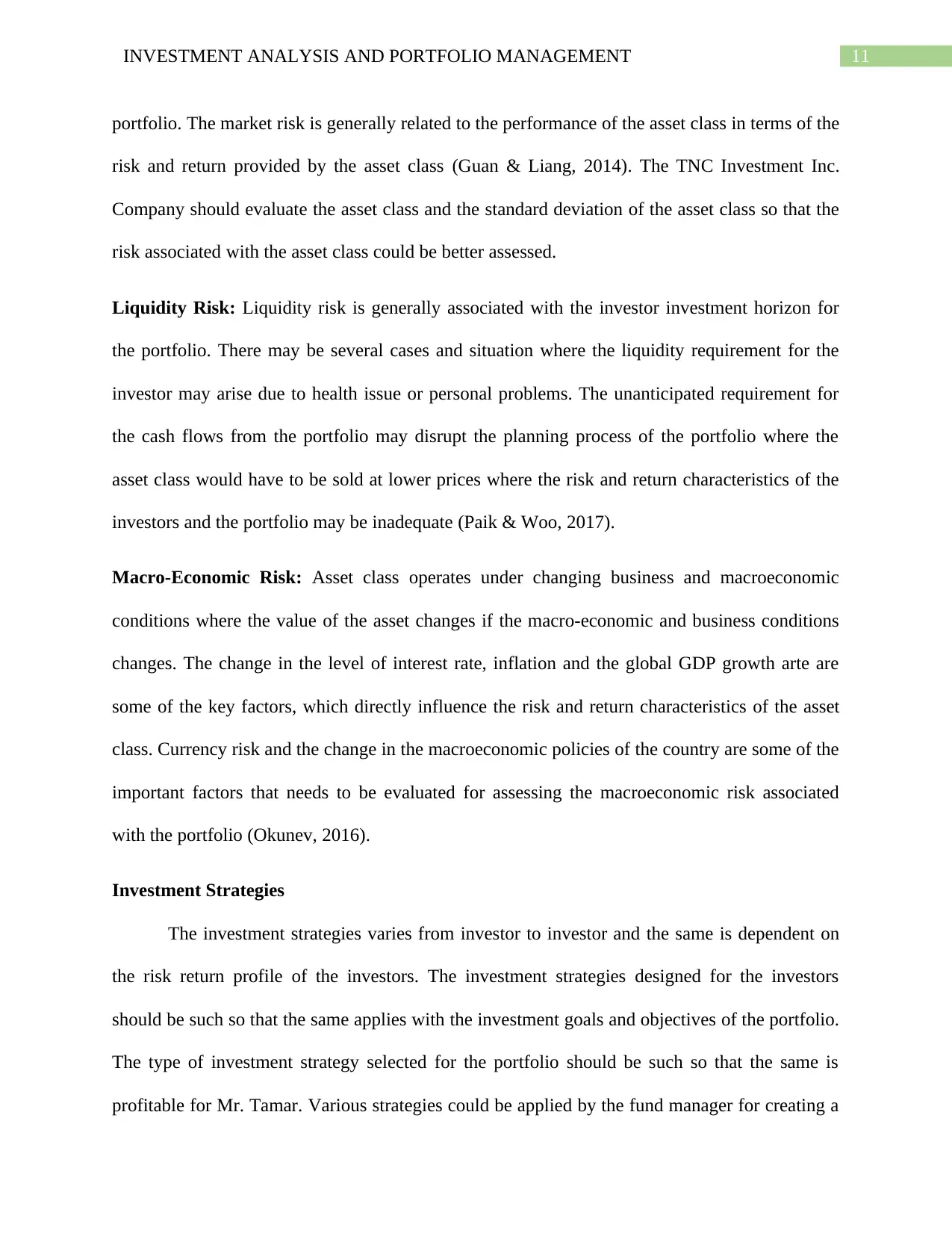
11INVESTMENT ANALYSIS AND PORTFOLIO MANAGEMENT
portfolio. The market risk is generally related to the performance of the asset class in terms of the
risk and return provided by the asset class (Guan & Liang, 2014). The TNC Investment Inc.
Company should evaluate the asset class and the standard deviation of the asset class so that the
risk associated with the asset class could be better assessed.
Liquidity Risk: Liquidity risk is generally associated with the investor investment horizon for
the portfolio. There may be several cases and situation where the liquidity requirement for the
investor may arise due to health issue or personal problems. The unanticipated requirement for
the cash flows from the portfolio may disrupt the planning process of the portfolio where the
asset class would have to be sold at lower prices where the risk and return characteristics of the
investors and the portfolio may be inadequate (Paik & Woo, 2017).
Macro-Economic Risk: Asset class operates under changing business and macroeconomic
conditions where the value of the asset changes if the macro-economic and business conditions
changes. The change in the level of interest rate, inflation and the global GDP growth arte are
some of the key factors, which directly influence the risk and return characteristics of the asset
class. Currency risk and the change in the macroeconomic policies of the country are some of the
important factors that needs to be evaluated for assessing the macroeconomic risk associated
with the portfolio (Okunev, 2016).
Investment Strategies
The investment strategies varies from investor to investor and the same is dependent on
the risk return profile of the investors. The investment strategies designed for the investors
should be such so that the same applies with the investment goals and objectives of the portfolio.
The type of investment strategy selected for the portfolio should be such so that the same is
profitable for Mr. Tamar. Various strategies could be applied by the fund manager for creating a
portfolio. The market risk is generally related to the performance of the asset class in terms of the
risk and return provided by the asset class (Guan & Liang, 2014). The TNC Investment Inc.
Company should evaluate the asset class and the standard deviation of the asset class so that the
risk associated with the asset class could be better assessed.
Liquidity Risk: Liquidity risk is generally associated with the investor investment horizon for
the portfolio. There may be several cases and situation where the liquidity requirement for the
investor may arise due to health issue or personal problems. The unanticipated requirement for
the cash flows from the portfolio may disrupt the planning process of the portfolio where the
asset class would have to be sold at lower prices where the risk and return characteristics of the
investors and the portfolio may be inadequate (Paik & Woo, 2017).
Macro-Economic Risk: Asset class operates under changing business and macroeconomic
conditions where the value of the asset changes if the macro-economic and business conditions
changes. The change in the level of interest rate, inflation and the global GDP growth arte are
some of the key factors, which directly influence the risk and return characteristics of the asset
class. Currency risk and the change in the macroeconomic policies of the country are some of the
important factors that needs to be evaluated for assessing the macroeconomic risk associated
with the portfolio (Okunev, 2016).
Investment Strategies
The investment strategies varies from investor to investor and the same is dependent on
the risk return profile of the investors. The investment strategies designed for the investors
should be such so that the same applies with the investment goals and objectives of the portfolio.
The type of investment strategy selected for the portfolio should be such so that the same is
profitable for Mr. Tamar. Various strategies could be applied by the fund manager for creating a
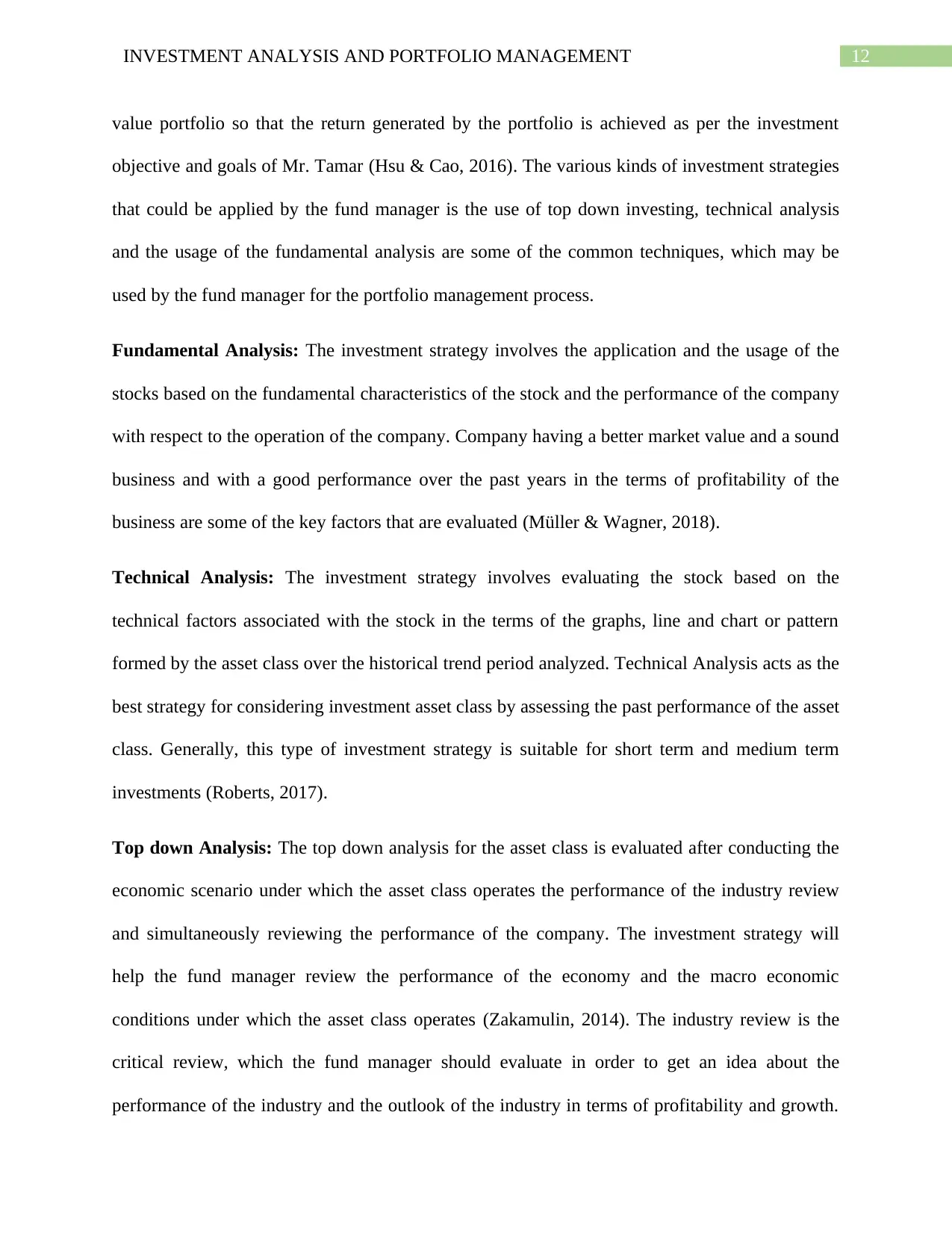
12INVESTMENT ANALYSIS AND PORTFOLIO MANAGEMENT
value portfolio so that the return generated by the portfolio is achieved as per the investment
objective and goals of Mr. Tamar (Hsu & Cao, 2016). The various kinds of investment strategies
that could be applied by the fund manager is the use of top down investing, technical analysis
and the usage of the fundamental analysis are some of the common techniques, which may be
used by the fund manager for the portfolio management process.
Fundamental Analysis: The investment strategy involves the application and the usage of the
stocks based on the fundamental characteristics of the stock and the performance of the company
with respect to the operation of the company. Company having a better market value and a sound
business and with a good performance over the past years in the terms of profitability of the
business are some of the key factors that are evaluated (Müller & Wagner, 2018).
Technical Analysis: The investment strategy involves evaluating the stock based on the
technical factors associated with the stock in the terms of the graphs, line and chart or pattern
formed by the asset class over the historical trend period analyzed. Technical Analysis acts as the
best strategy for considering investment asset class by assessing the past performance of the asset
class. Generally, this type of investment strategy is suitable for short term and medium term
investments (Roberts, 2017).
Top down Analysis: The top down analysis for the asset class is evaluated after conducting the
economic scenario under which the asset class operates the performance of the industry review
and simultaneously reviewing the performance of the company. The investment strategy will
help the fund manager review the performance of the economy and the macro economic
conditions under which the asset class operates (Zakamulin, 2014). The industry review is the
critical review, which the fund manager should evaluate in order to get an idea about the
performance of the industry and the outlook of the industry in terms of profitability and growth.
value portfolio so that the return generated by the portfolio is achieved as per the investment
objective and goals of Mr. Tamar (Hsu & Cao, 2016). The various kinds of investment strategies
that could be applied by the fund manager is the use of top down investing, technical analysis
and the usage of the fundamental analysis are some of the common techniques, which may be
used by the fund manager for the portfolio management process.
Fundamental Analysis: The investment strategy involves the application and the usage of the
stocks based on the fundamental characteristics of the stock and the performance of the company
with respect to the operation of the company. Company having a better market value and a sound
business and with a good performance over the past years in the terms of profitability of the
business are some of the key factors that are evaluated (Müller & Wagner, 2018).
Technical Analysis: The investment strategy involves evaluating the stock based on the
technical factors associated with the stock in the terms of the graphs, line and chart or pattern
formed by the asset class over the historical trend period analyzed. Technical Analysis acts as the
best strategy for considering investment asset class by assessing the past performance of the asset
class. Generally, this type of investment strategy is suitable for short term and medium term
investments (Roberts, 2017).
Top down Analysis: The top down analysis for the asset class is evaluated after conducting the
economic scenario under which the asset class operates the performance of the industry review
and simultaneously reviewing the performance of the company. The investment strategy will
help the fund manager review the performance of the economy and the macro economic
conditions under which the asset class operates (Zakamulin, 2014). The industry review is the
critical review, which the fund manager should evaluate in order to get an idea about the
performance of the industry and the outlook of the industry in terms of profitability and growth.
⊘ This is a preview!⊘
Do you want full access?
Subscribe today to unlock all pages.

Trusted by 1+ million students worldwide
1 out of 21
Related Documents
Your All-in-One AI-Powered Toolkit for Academic Success.
+13062052269
info@desklib.com
Available 24*7 on WhatsApp / Email
![[object Object]](/_next/static/media/star-bottom.7253800d.svg)
Unlock your academic potential
Copyright © 2020–2025 A2Z Services. All Rights Reserved. Developed and managed by ZUCOL.





